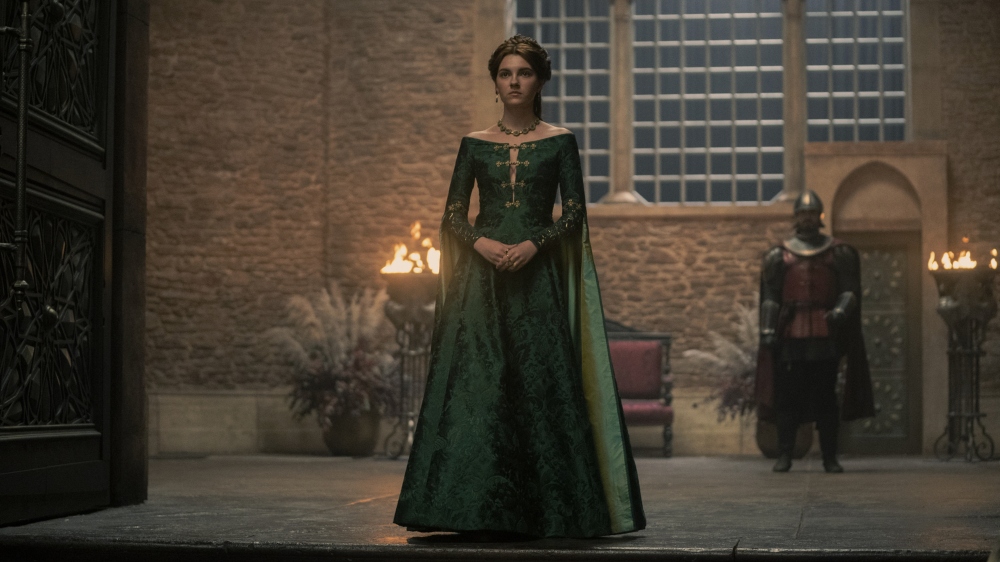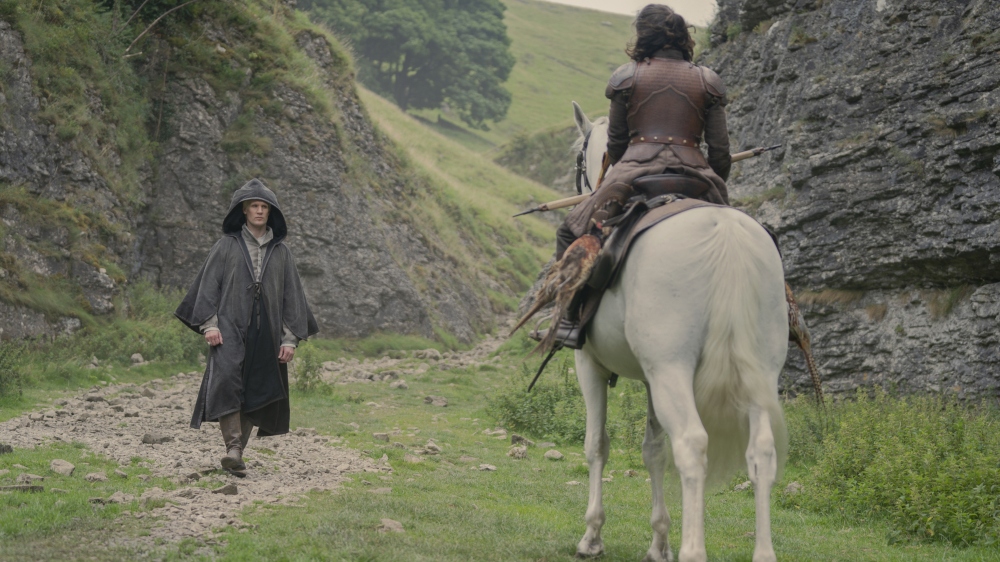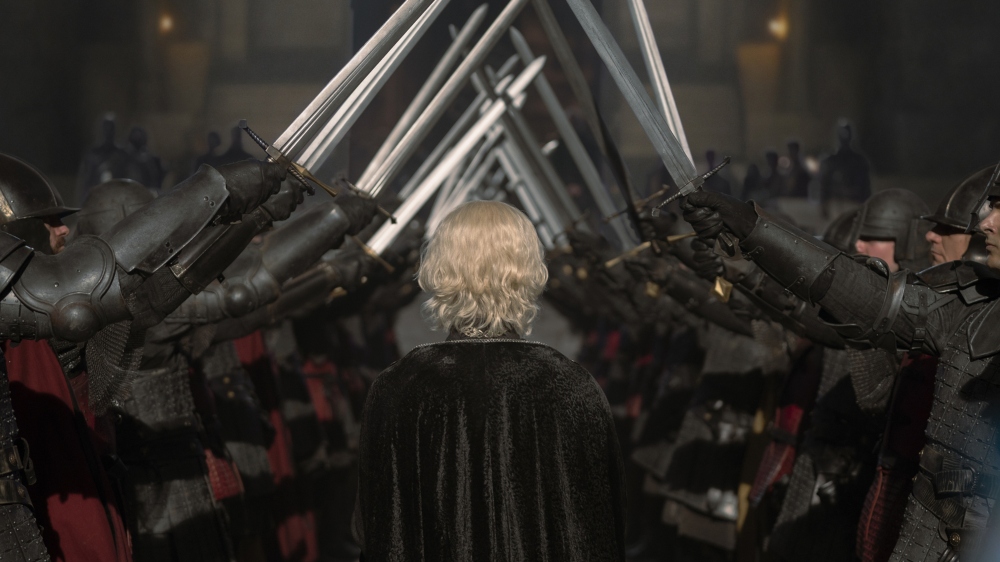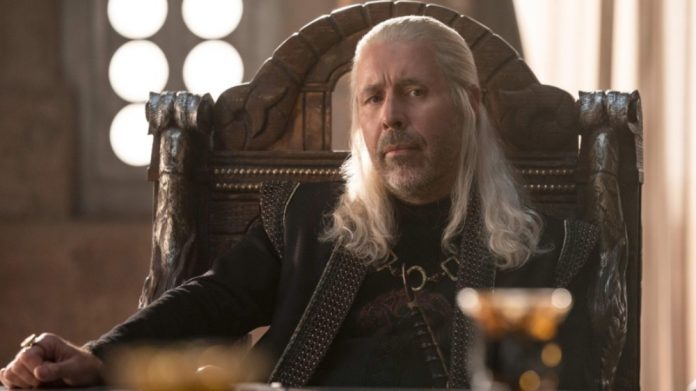HBO’s megahit Game of Thrones was ambitious enough in its own right, and its acclaimed prequel series, House of the Dragon, captured the same fantasy spark with an entirely new cast and set of murderous squabbles. Over the course of 10 episodes, Season 1 featured many memorable confrontations and elaborately-staged setups for character conflicts, all of which had tremendous reverberations.
Director Clare Kilner, who started her career helming romantic comedies like How to Deal and The Wedding Date, was behind the camera for three of those hours, including the penultimate episode of the season, “The Green Council,” which appears on the Emmy ballot as one of the show’s four submitted installments in the drama directing category.
Above the Line recently spoke with Clare Kilner about the challenges — and joys — of working extensively with visual effects and tapping into the show’s character dynamics. She also shared the intention behind subtler scenes that weren’t CGI-heavy and reflected on the opportunity to work with different actors portraying the same roles.

Above the Line: What was your level of Game of Thrones fandom before coming aboard House of the Dragon? I imagine you had to be intimately familiar with that whole universe…
Clare Kilner: I loved Game of Thrones and I was really into it. The deeper it got into the series, the more I got into it as well, because I really saw the evolution from Season 1 to the final seasons. I am a big fan of dysfunctional family drama, and to me, it was like a dream come true to be offered this job because no matter what genre, be it fantasy, comedy, or just pure drama, it’s always interesting to tackle subject matter like that because it’s about character and relationships, and especially in this environment, power.
And I just think those dynamics are fascinating. You can dive into them and really explore them in deep and meaningful ways. That’s what I really loved about the show. Of course, the whole fantasy element, and the dragons, and this incredible world that George R.R. Martin has created is very seductive. And it’s got a huge fan base, which I’ve come to know after Season 1 came out. It was just a real pleasure.
ATL: There are so many large-scale scenes that I imagine are 95 percent visual effects. How does that work for you, directing a scene that will largely be crafted during post-production?
Kilner: Episode 9, the dragon pit, it’s a couple of lines in the script. The dragon emerges from beneath and rises up in front of the dais with all the royals on it. It’s a couple of lines in the script, but obviously, it’s a hugely complicated endeavor, which requires an incredible amount of collaboration from the technical departments — from the set [decorator] and production design, and from the actors. The budget side, as well, has to be taken into consideration. So it’s really a process. When you first look at it, it seems [like] so much and so difficult, and I hadn’t tackled a scene that big with all that CGI, [so] I was definitely nervous about how to approach it. But it’s still telling a story, and so you break it down — what are the emotional beats within the scene and how do you express that visually?
What was especially challenging was the dragon pit itself was meant to be the size of a football stadium, but the studio was only, like, a third of the size of a football stadium. So, for example, when Rhaenys comes through those huge incredible doors that Jim Clay, the production designer, built, which was still only a third of the size of what the doors would actually ultimately be, she walks in and has to do her scene to a bluescreen. Because then we have to shoot all the royals on the dais separately and shrink them down to get the perspective right from Rhaenys looking to the dais. And, of course, the same has to happen from the royals on the dais where Aegon is crowned looking back to all the people.
Initially, Aegon was meant to be coming in on a horse, but for whatever reason, we weren’t allowed to do that, so I had to explore… “How can we make a grand entrance?” So, I looked at lots of military videos and I saw something with all the swords and an arch. I love the use of sound in film and TV, and I just loved the idea of all these swords coming down behind him as he goes through. Also, I was really interested in the idea of having this archway of swords and then him seeing his mother at the end of it. He’s just focusing [on] “Get to mommy.”
[So] we created that, but we also only had about 50 or 60 extras, supporting artists, to do that, but they weren’t military-trained, [so] we brought in a military guy to train them up in about four hours. So that was pretty cool, and it was quite an interesting exercise for them. I don’t think they knew quite what had hit them, but then again, we had to shoot that three times over because we needed a much longer archway. The other aspect that was challenging is we had to have everyone running for the doors and then falling into the hole that Meleys left as the dragon rose.
On a blue screen, we do sprites where we literally shoot someone on a harness being catapulted up or falling down from a height and then we build and add all these elements and composite them into the final sequence. We also had to do tiling, which is, for example, taking 200 people running for their lives and screaming over and over again so we can add all of those into the scene. And that was really fun. I have to say, the SAs really went for it, and it’s actually quite fun directing people to feel like their lives are in danger, especially when they just go for it.
I guess, in that sequence, the other thing that was interesting was for Alicent and Aegon and Otto and Helaena and Aemond on that stage, they’ve got to react to this dragon coming out of the ground, which isn’t really there. So we have someone on a pole with a stick with a balloon on the end, or a blue ball on the end, and then there’s me on a microphone — because they’ve all got to look at the same point as well, which is the head of the dragon — saying ‘and the dragon’s coming out, and there’s dust everywhere and you can’t see a thing,’ because, also, the dust is added later. ‘And now he’s drawing his breath! Is he going to burn you?’ So they all react to that, and then we bring on these huge wind machines that blow everyone’s hair back as the dragon is about to take a breath. And you have to shoot that from many different [angles]. That is [the] challenge of a scene like that.

ATL: It makes sense that, of the three episodes you directed, that’s the one that’s on the Emmy ballot, since it seems certainly like the most ambitious in many ways.
Kilner: Thank you, yeah.
ATL: These episodes are so dense in a great way, where so much happens in every episode. Looking back at Episode 5, Alicent coming in with those battle colors feels like a very intentional scene. What can you tell us about that episode?
Kilner: That whole wedding was amazing and interesting. Also, the thing is, there’s a wedding and they dance, but I had never seen a dance in Game of Thrones or what the style of dance was. So I worked with a really great choreographer [named] Francesca Jaynes, who I worked with on my very first movie. [So] I brought her in, and we took some of her dancers to Pineapple Studios and drew references from ancient birds and their movement. And we watched them and concocted the dance from that world because I didn’t want it to be too much of a Jane Austen dance. I felt we needed to come up with something a little bit more tribal in a way. I really loved it when they throw their arms in the air and go, “hey, hey!” Because you want to get this sense of this slight madness increasing as people get drunker and the wedding’s gone on for longer — inhibitions flying and things like that.
We also had to really think about the layout in the throne room [and] how we’d get the most bang for our buck in terms of seeing the layers of all the tables, because in the previous Game of Thrones weddings, everyone was sort of in a line with benches, and we felt that in that space, we wouldn’t be able to have a space to dance. So we spent a lot of time thinking about how all that was going to be arranged. We had so many entrances because we had Laenor’s entrance and the sea snake and all of that. We had the twins coming in, the Lannister twins, at the beginning, and then Alicent, resplendent in her dress. I knew I was going [to] love that moment. It’s a show-stopping moment and Emily Carey did a fantastic job. I also loved working on that relationship between Alicent and Rhaenyra at that point when they’re just giving daggers to each other in what is meant to be a very civil environment.
ATL: What was it like to then work with their adult counterparts in Episode 9?
Kilner: It was a real shock! But Olivia [Cooke], I just so enjoy working with her, and especially that scene between Olivia and Eve Best when they’re really having that discussion about the different ways to work as a woman to be able to find agency in a man’s world. One of them thinks you can work from within and shape and challenge traditions and the way things are from within if you go with it, and [the] other one thinks [she] can see — and she’s got the experience behind her to see — that there’s no way that you can really do that. You have to fight for your side and you probably won’t win.

ATL: I’m thinking also of a much smaller scale scene, which is the one with Daemon killing his wife, Lady Rhea, which is very disturbing. It’s also one of the most sparsely decorated scenes in the entire show. What goes into an intimately violent scene like that?
Kilner: That’s what was exciting about doing that. We shot that in Derbyshire in this incredible landscape. What I wanted to bring to it, very much, was her on the horse, galloping free through the landscape so [that] we really got a little bit more of a sense of her and how adventurous and what a rebellious character she was before we killed her. I didn’t want to just see her and have her die.
It was really great with Matt and Rachel when they met. They were very interested in each other because they both are sparky and rebellious characters by nature and like to challenge things. So it was really fun to see them coming together — their banter and repartee, and how they pushed each other’s buttons. It was just dark and shocking to see how Daemon could turn on a dime and decide to do what he did. I just wanted to build as much tension beforehand, before the horse reared.
It was interesting, because I think it ended in the script with him picking up the stone, and we shot a few different versions. Matt wanted to find an intimate moment there before killing her. We shot a moment where he kissed her and then we shot a moment where I just wanted to see them look each other in the eyes and then him pick up the stone. And Matt is very good at turning things on their head and surprising you as a director. I always just encourage that because I think when you read something in the script, you’ve always got to challenge it and question it and think, “What if he does this with kindness? What if he does this with love rather than with hate?” And it sounds like a weird thing, but therein lies the mystery.
ATL: Will you be back to direct episodes for Season 2?
Kilner: I’m doing them right now! I’ve literally just come off [the] set. I’m doing Episodes 2 and 5, and I had this incredible, brilliant day today. We had a lot to do, and we just got it. We got that last close-up 30 seconds before we were meant to finish, so I’m happy and high off that.

ATL: I won’t ask any questions about that since I don’t want either of us to get in trouble, but looking back, I see that you’ve done a lot of individual episodes of a bunch of different shows that I’ve seen, such as The Mosquito Coast, Sneaky Pete, and more. The one I want to ask you about is Good Behavior because it’s such a unique show that should be on Season 6 or something right now, but its run was cut short. What was it like coming on to direct a Season 2 episode for that show?
Kilner: For me, that was quite a break, getting that episode, because I had worked in film beforehand and I was trying to break into TV and I couldn’t. It was very hard and, to be honest, it was quite hard as a woman to break into TV at that point, about six years ago. Things definitely have changed a lot since then. But I had done an episode of The Middle. I had done big studio movies before that, but I hadn’t done much TV. Chad Hodge at Tomorrow Studios took a punt on me, and I was very nervous going in.
I loved the script. That relationship between Juan Diego Botto and Michelle Dockery was just fun, and they were both such great actors to work with. They came with so many ideas, and the scripts gave me so many ideas as well. I enjoyed that job so much. I think it was really Chad’s very unique tone that he brought to that, and his writing has so many layers and so much depth. I’m always fascinated by people pretending to be who they’re not. I always have secret desires to be someone other than myself. What would happen if…? It’s entertaining, humorous fun, but also very heartwarming.
ATL: I think a lot of people who come in to read an interview with the director of House of the Dragon will be surprised to hear that some of your earlier film credits include How to Deal and The Wedding Date. Can you explain how you got from there to here?
Kilner: I guess I’m always drawn to the writing. When I was at film school, I was first into doing really dark material about grief, family dysfunction, and death. And then for my graduation film, I made a dark comedy, and I didn’t even know if I could do comedy. But when we had the screenings, everyone was really laughing. So, that was fun, to make people laugh. There’s just something in me that I do find humor in whatever I do, whatever genre.
I made my first film, which was a quirky rom-com [titled] Janice Beard 45 WPM, which was about my life. I was a temp secretary for many years. I went to film school at 29. I had all this experience, so I said, ‘I’ll write a film about what I know [of] being a temp secretary.’ That had humor. That was sort of comedic. I think that led me to the other offers.
Season 1 of House of the Dragon is now streaming on Max, and HBO has renewed the show for Season 2.



